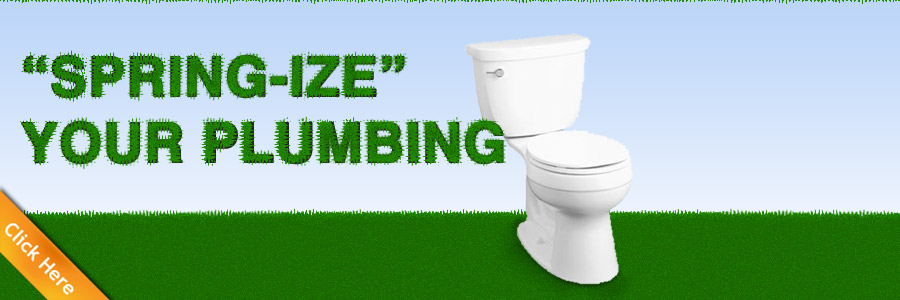With the spring come…chores! It’s like everyone is coming out of hibernation—and realizing there’s a ton of stuff to clean, de-clutter, de-gunk or repair.
A lot of people don’t realize it, but just as you want to winterize your plumbing in the winter, you want to “spring-ize” your plumbing in the spring—especially since the Richmond monsoon season is upon us.

- If it ain’t broke, check it anyway. Pour a gallon of water into infrequently used drains (including floor drains) to fill the trap and prevent odors from entering the house. Slow floor drains should be snaked to ensure they will carry away water quickly in the event of a flood.
- How can you tell if there’s a leak you can’t see? Inspect for slow leaks in your home by taking a reading on your water meter before bedtime. Don’t use any water overnight, then take another reading in the morning. If the reading has changed, you have a leak that should be repaired.
- A clog can happen anywhere! Make sure you check and clean all yard drains, gutters and downspouts, so that your yard doesn’t flood and ruin your landscaping or your home. Sometimes, a flooded yard can turn into water seeping into basements, garages, or other places where it shouldn’t be.
- Can’t take the heat? Check to make sure the temperature setting on your water heater is set no higher than 120°F to prevent scalding (especially if you have children in your home) and to reduce energy use.
- Add life to your water heater. Carefully drain several gallons from the water heater tank to flush out corrosion causing sediment, which reduces heating efficiency and shortens the life of the heater.
- How do I know when to get a new water heater? Consider replacing a water heater that is more than 15 years old. (The first four numbers of the serial number represent the month and year it was made.) Newer water heaters are more energy efficient, so it will probably save you money in the long run too.
- What you should never store near a water heater or furnace. Make sure flammables are not stored near the water heater or furnace, such as cardboard, wood, or really any clutter. It’s best to leave plenty of space free around these appliances for safety and to make it easier to reach them in a hurry. (It’s especially important to remind tenants about this, if you rent property.)
- Th’ar she blows! Check dishwasher, washing machine and icemaker supply hoses for bulges or leaks. Replace hoses that show signs of weakness or are older than 10 years. Rubber washing machine hoses should be replaced after 3-5 years. We recommend replacing them with stainless steel braided hoses, which have a lifetime guarantee.
- What a drip! Check faucets, the base of your toilet and the pipes and hoses under sinks for drips or leaks. Make repairs to save water.
- Best investment advice of 2011! Use strainers in all your drains to prevent hair, soap and debris from clogging the drain lines. They’re cheap and can be found in most dollar stores or home repair stores. Spend a dollar or less and save anywhere from $150-200 or more on a maintenance call. Not a bad return on your investment!
- Add a touch of color to your…toilet? Add six drops of food coloring to the toilet tank (any color you like!). If the toilet is leaking, color will appear in the bowl within 30 minutes.
- Let’s get physical! Exercise water supply valves under sinks and toilets to prevent them from sticking.
- No more jiggling. Make sure toilets flush properly. If you have to hold the toilet handle down for a thorough flush or jiggle the handle to stop the water from running, you may need to replace worn tank parts. They’re inexpensive, and you’ll notice a lower water bill—not to mention all the time you’ll save, not having to jiggle the handle anymore.
- No more deposits! Clean mineral deposits from showerheads. Unscrew it and soak in vinegar. You could also fill a plastic baggy with vinegar, place it over the showerhead and hold in place with a rubber band. Soak overnight, then remove and gently scrub with an old toothbrush to remove deposits.
These are easy ways to get started and to get to know your plumbing system better. But don’t spend all your time checking pipes and hoses! Get out and enjoy the spring weather too! You’ll definitely enjoy it more, knowing you’ve done your part to keep your plumbing in great shape for the new season.


